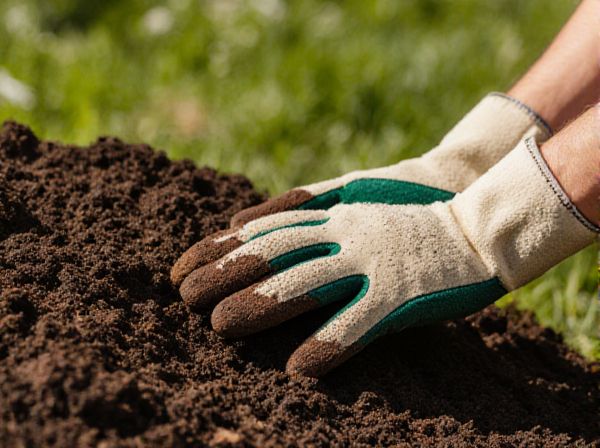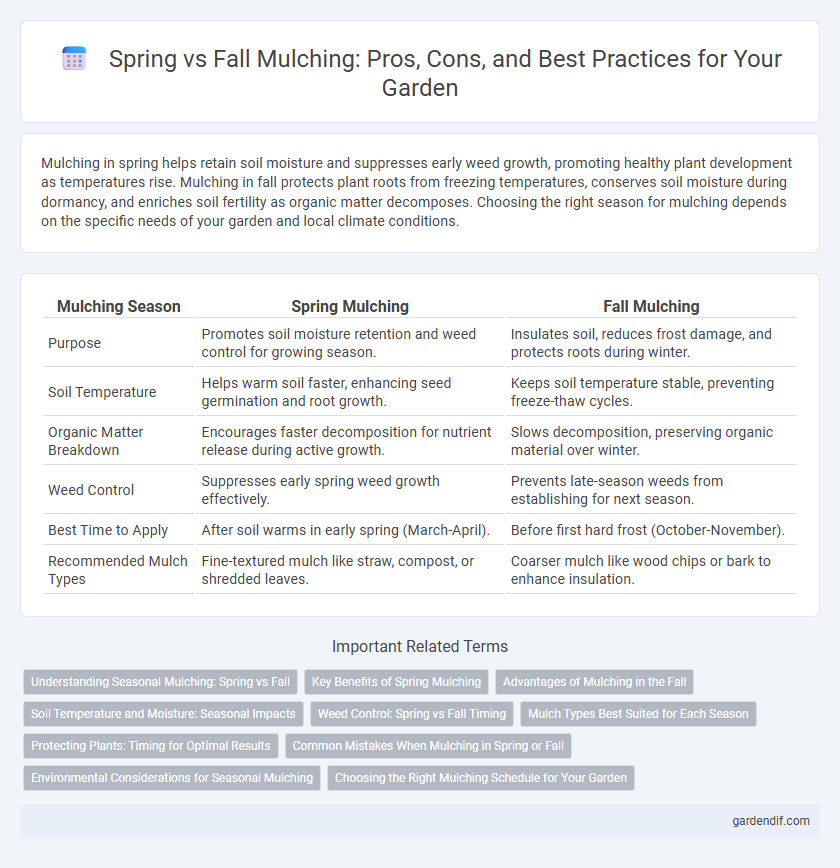
Mulching in Spring vs Mulching in Fall Illustration
Mulching in spring helps retain soil moisture and suppresses early weed growth, promoting healthy plant development as temperatures rise. Mulching in fall protects plant roots from freezing temperatures, conserves soil moisture during dormancy, and enriches soil fertility as organic matter decomposes. Choosing the right season for mulching depends on the specific needs of your garden and local climate conditions.
Table of Comparison
| Mulching Season | Spring Mulching | Fall Mulching |
|---|---|---|
| Purpose | Promotes soil moisture retention and weed control for growing season. | Insulates soil, reduces frost damage, and protects roots during winter. |
| Soil Temperature | Helps warm soil faster, enhancing seed germination and root growth. | Keeps soil temperature stable, preventing freeze-thaw cycles. |
| Organic Matter Breakdown | Encourages faster decomposition for nutrient release during active growth. | Slows decomposition, preserving organic material over winter. |
| Weed Control | Suppresses early spring weed growth effectively. | Prevents late-season weeds from establishing for next season. |
| Best Time to Apply | After soil warms in early spring (March-April). | Before first hard frost (October-November). |
| Recommended Mulch Types | Fine-textured mulch like straw, compost, or shredded leaves. | Coarser mulch like wood chips or bark to enhance insulation. |
Understanding Seasonal Mulching: Spring vs Fall
Spring mulching enhances soil moisture retention and weed control just as plants emerge, promoting early root growth and nutrient availability. Fall mulching moderates soil temperature, protects roots from freezing, and enriches soil organic matter during dormancy. Selecting mulch timing based on plant type and climate optimizes garden health and seasonal growth cycles.
Key Benefits of Spring Mulching
Spring mulching enhances soil moisture retention, promoting early root development and improving plant growth during the growing season. It helps regulate soil temperature, protecting young plants from late frosts and reducing weed emergence. Unlike fall mulching, spring application allows for better nutrient availability and soil aeration as plants actively grow.
Advantages of Mulching in the Fall
Mulching in the fall improves soil moisture retention by reducing evaporation during colder months, promoting healthier root growth before winter dormancy. It helps regulate soil temperature, protecting plant roots from extreme fluctuations and reducing frost damage. Fall mulching also suppresses weed growth in early spring, minimizing competition for nutrients as plants begin to emerge.
Soil Temperature and Moisture: Seasonal Impacts
Mulching in spring helps retain soil moisture and moderate soil temperature as the ground warms, promoting early root growth and reducing evaporation. In contrast, fall mulching insulates the soil against freezing temperatures, preserving moisture and protecting plant roots over winter. Seasonal mulching optimizes soil conditions by stabilizing temperature fluctuations and maintaining adequate moisture levels essential for plant health.
Weed Control: Spring vs Fall Timing
Mulching in fall provides superior weed control by suppressing early weed germination and creating a barrier that prevents seeds from sprouting during winter and early spring. Spring mulching helps manage weed growth by shading emerging seedlings and retaining moisture but is less effective at stopping weeds that have already germinated. Optimal timing for mulch application can significantly reduce weed pressure, enhancing overall garden health throughout the growing season.
Mulch Types Best Suited for Each Season
Organic mulches such as shredded bark, straw, and composted leaves are ideal for spring mulching, providing moisture retention and soil warming to support early plant growth. In contrast, fall mulching benefits from hardwood mulch and pine needles, which offer insulation against cold temperatures and help protect root systems during winter. Applying the appropriate mulch type each season enhances soil health and promotes plant resilience throughout the year.
Protecting Plants: Timing for Optimal Results
Mulching in spring helps regulate soil temperature and retain moisture, promoting healthy plant growth during the active growing season. Mulching in fall provides insulation against harsh winter temperatures, reducing frost damage and soil erosion. Proper timing ensures plants receive protection when they need it most, enhancing overall resilience and vitality.
Common Mistakes When Mulching in Spring or Fall
Applying mulch too early in spring can trap moisture and promote fungal growth, while mulching too late in fall may prevent soil from warming properly before winter. Using excessive mulch thickness in either season can suffocate plant roots and attract pests. Avoid piling mulch directly against plant stems or tree trunks to prevent decay and rodent damage regardless of the mulching season.
Environmental Considerations for Seasonal Mulching
Spring mulching enhances soil moisture retention and temperature regulation, promoting early plant growth while reducing erosion and nutrient runoff. Fall mulching improves winter soil insulation, protecting roots from frost damage and slowing organic matter decomposition to enhance soil fertility. Selecting mulch type and timing tailored to seasonal weather patterns optimizes environmental benefits and supports sustainable garden ecosystems.
Choosing the Right Mulching Schedule for Your Garden
Mulching in spring promotes soil moisture retention and temperature regulation, encouraging early plant growth, while mulching in fall protects roots from freezing temperatures and reduces weed growth during winter. Selecting the optimal mulching schedule depends on your local climate, plant types, and specific garden needs, ensuring enhanced soil health and plant vitality. Proper timing maximizes the benefits of organic materials like wood chips, straw, or compost, optimizing nutrient release and soil insulation.
Mulching in Spring vs Mulching in Fall Infographic

 gardendif.com
gardendif.com